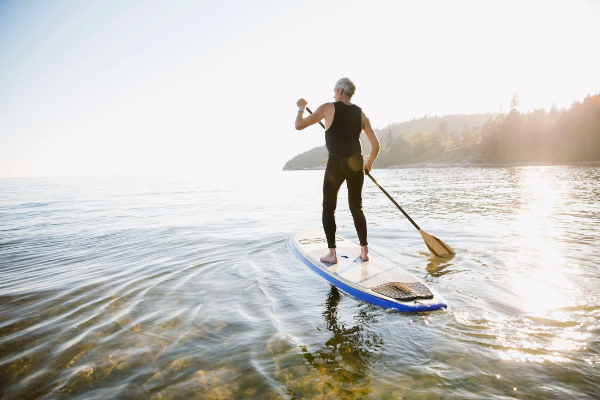Stand Up Paddleboarding (SUP) is a fantastic way to enjoy the water, offering both a great workout and a peaceful connection with nature. Whether you’re a complete beginner or looking to refine your skills, this guide will cover everything you need to know to get started and become proficient in riding a SUP board.
Understanding the Basics
What is SUP?
SUP stands for Stand Up Paddleboarding. It’s a water sport where you stand on a large board and use a paddle to propel yourself across the water. It’s versatile, suitable for all water conditions from oceans to lakes to rivers.
Benefits of SUP
SUP is excellent for fitness. It works your core, improves balance, and builds strength. It’s also a low-impact exercise, making it gentle on your joints. Plus, it’s a great way to relax and enjoy nature.
Choosing the Right Equipment
Types of SUP Boards
There are several types of SUP boards:
- All-Around SUPs: Versatile and great for beginners.
- Touring SUPs: Designed for long distances and smooth gliding.
- Surf SUPs: Shorter and more maneuverable, ideal for riding waves.
- Racing SUPs: Long and narrow for speed and efficiency.
- Yoga SUPs: Wider for stability during yoga poses.
Selecting a Paddle
The paddle is crucial. It should be about 6-10 inches taller than you. Paddles come in different materials like aluminum, fiberglass, and carbon fiber. Lighter paddles reduce fatigue.
Other Gear
- Leash: Keeps you connected to your board.
- Personal Flotation Device (PFD): Safety is paramount, especially in deeper waters.
- Appropriate Clothing: Wear swimwear or quick-drying clothes. Wetsuits are great for cold water.
Learning to Stand Up
Start on Calm Water
Choose a calm, flat water location. A lake or a slow-moving river is ideal for beginners.
Position Yourself
- Place your board in shallow water.
- Kneel in the center of the board, with the paddle across the board.
- Slowly stand up one foot at a time, keeping your knees slightly bent.
Finding Your Balance
- Stand with feet parallel and shoulder-width apart.
- Keep your knees bent and core engaged.
- Look at the horizon, not your feet.
Basic Paddling Techniques
Holding the Paddle
- Place one hand on the top grip and the other on the shaft.
- Keep your arms straight and use your core to paddle.
Forward Stroke
- Reach the paddle forward, insert the blade into the water, and pull back towards your ankle.
- Switch sides to keep the board moving straight.
Turning the Board
- Sweep Stroke: Reach the paddle to the front and sweep in a wide arc to turn the board.
- Back Paddle: Paddle backward on one side to turn quickly.
Advanced Techniques
The Pivot Turn
- Move your back foot to the tail of the board.
- Use a sweeping stroke to turn the board quickly.
SUP Surfing
- Approach waves at an angle.
- Shift your weight to the back foot as you catch the wave.
- Use short, quick strokes to maneuver on the wave.
Safety Tips
Weather Awareness
- Check the weather forecast before heading out.
- Avoid strong winds and storms.
Stay Hydrated
- Bring water, especially on long paddles.
- Wear sun protection to avoid sunburn.
Paddle with a Buddy
- It’s safer and more fun to paddle with a friend.
- Always let someone know your plans if you’re paddling alone.
SUP Etiquette
Respect Other Water Users
- Give right of way to swimmers and other paddlers.
- Avoid crowded areas to prevent accidents.
Environmental Respect
- Don’t disturb wildlife.
- Pack out all trash and respect nature.
SUP Fitness and Yoga
SUP Workouts
- Incorporate intervals of fast paddling and slow paddling.
- Use the board for bodyweight exercises like squats and push-ups.
SUP Yoga
- Practice yoga poses on the board to enhance balance and core strength.
- Start with simple poses like child’s pose and progress to more challenging ones.
Maintenance and Care
Cleaning Your Board
- Rinse with fresh water after use, especially in saltwater.
- Store in a cool, dry place away from direct sunlight.
Checking Your Gear
- Inspect your paddle and leash for any signs of wear.
- Ensure your PFD is in good condition and fits properly.
Joining the SUP Community
Finding Local Groups
- Join local SUP clubs or groups.
- Participate in events and meetups.
Competitions and Events
- Try participating in local SUP races.
- Engage in charity paddles and community events.
See Also: What Is Discover Scuba Diving
Common Mistakes and How to Avoid Them
Poor Stance
- Keep your knees bent and core engaged.
- Avoid leaning too far forward or backward.
Incorrect Paddling Technique
- Use your core, not just your arms.
- Keep the paddle vertical to maximize efficiency.
Overlooking Safety
- Always wear a leash and PFD.
- Be mindful of weather conditions and water traffic.
Conclusion
SUP is a rewarding and accessible sport. With the right equipment, practice, and safety measures, you can enjoy countless hours on the water. Embrace the learning process, connect with the SUP community, and most importantly, have fun out there!

